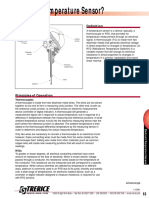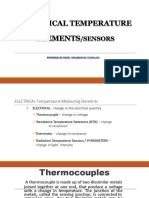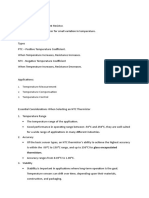Sensor Compare Chart
Uploaded by
Popescu QescuSensor Compare Chart
Uploaded by
Popescu QescuTemperature Sensing
Technical Data
Comparing Three Types Of Temperature Sensors
RTDS VS. THERMOCOUPLES VS. THERMISTORS
RTDs Thermocouples Thermistors
Resistance Temperature Detectors A thermocouple consists of two wires of Thermistors are resistive devices usually
(RTDs) are temperature sensing devices dissimilar metals welded together into a made of metal oxides formed into a bead
consisting of a wire coil or deposited film junction. At the other end of the signal and encapsulated in epoxy or glass.
of pure metal, usually platinum. The ele- wires, usually as part of the input instru- Thermistors show a large negative tem-
ment’s resistance increases with tempera- ment, is another junction called the refer- perature coefficient. Their resistance
ture in a known and repeatable manner. ence junction. Heating the sensing junc- drops dramatically and non-linearly with
RTDs exhibit excellent accuracy over a tion generates a thermoelectric potential a temperature increase. A thermistor’s
wide temperature range, –200 to 650°C (emf) proportional to the temperature dif- sensitivity is many times that of an RTD,
(–328 to 1202°F). ference between the two junctions. This but its useful temperature range is limit-
millivolt-level emf, when compensated ed.
for the known temperature of the refer- Because of wide variations of perfor-
ence junction, indicates the temperature
———— RTDs offer ————
Stability and repeatability: The plat- mance and cost among thermistors, gen-
at the sensing tip. Published millivolt eralized advantages and disadvantages
inum RTD is the primary interpolation tables assume the reference junction is at may not always apply.
instrument used by the National Institute 0 degrees Celsius.
of Standards and Technology from –260
degrees Celsius to 630 degrees Celsius. Thermocouples are simple and familiar.
Designing them into systems, however, is
———— Typical benefits are ————
Precision RTDs can be manufactured
with a stability of 0.0025 degrees Celsius complicated by the need for special Lower Sensor Cost: Basic thermistors
per year. However, most industrial mod- extension wires and reference junction are less costly than RTDs and thermocou-
els drift less than 0.1 degrees Celsius per compensation. ples, but when assembled in protective
year. sheaths or wells the price difference nar-
rows. Thermistors with tighter inter-
Linearity: The platinum RTD produces a changeability or extended temperature
—Thermocouple advantages include—
more linear curve than thermocouples or ranges often cost more than RTDs.
thermistors. The RTD’s non-linearities Thermocouples with a noble metal junc-
Extremely high temperature capability:
can be corrected through proper design of tion may be rated as high as 1700°C High Sensitivity: Resistance may be sev-
resistive bridge networks. (3100°F). eral thousand ohms, which provides a
larger output than RTDs with the same
Sensitivity: The voltage drop across an measuring current, offsetting lead wire
RTD provides a much larger output than a Ruggedness: The inherent simplicity of
thermocouples makes them resistant to resistance problems. Caution must be
thermocouple. Since thermistors have a taken to limit measuring current because
higher resistance than RTDs, the measur- shock and vibration.
thermistors are more susceptible to self-
ing current through them may be so low heating than are RTDs.
Small size/fast response: A fine-wire
as to limit self-heating, making their volt- thermocouple junction takes up little Point Sensing: A thermistor bead may
age drop less than that of an RTD. space and has low mass, making it suitable be the size of a pinhead, allowing for
Standardization: RTDs are manufac- for point sensing and fast response. small area sensing.
tured to industry standard curves, usually
100 ohm platinum to IEC 751, which
makes them very interchangeable.
System Cost: RTDs usually offer a
lower system cost than do thermocouples
as they use ordinary copper extension
leads and require no cold junction com-
pensation.
View Product Inventory @ www.tempco.com
14-46
Temperature Sensing
RTD Technical Data
TEMPCO’S What is Temperature Coefficient Interchangeability and
ACCU-OHM™ RTD of Resistance (TCR)? Repeatability
All of Tempco’s Accu-Ohm RTDs comply Temperature coefficient differentiates Interchangeability and accuracy are com-
with the following specifications: between resistance/temperature curves of monly cited as the RTDs most distinguish-
RTDs. It is also called ALPHA and may be ing attributes. Because of the tight toler-
IEC publication 751 issued by the International specified in various ways by different ances of the Class A and Class B, RTDs
Electrotechnical Commission (dated 1983). manufacturers. Here TCR is the RTDs are quite interchangeable. Their accuracy
This is the widest international scope of any resistance change from 0 to 100°C, divid- is also very good because of the RTD’s
RTD standard. This publication sets the tol- ed by the resistance at 0°C, divided by repeatability over the standard tempera-
erance for platinum RTDs with a value of 100°C: ture scale from –260°C to 630°C.
100 ohms at 0°C with a temperature coeffi- R 100°C − R 0°C Ordinary industrial RTDs tend to show a
cient of resistance (TCR) of 0.00385 TCR (Ω/Ω/°C) = drift of less than 0.1°C per year in normal
ohms/ohm/°C in one of two classes: R 0°C × 100°C
use.
Class A: Plus or minus 0.06% at 0°C Example: A platinum RTD measuring 100 Because RTDs are exactly what the name
Class B: Plus or minus 0.12% at 0°C Ω’s at 0°C and 138.5 Ω’s at 100°C implies (Resistance Temperature
has TCR 0.00385 Ω/Ω/°C Detectors), a resistance type sensor, any
resistance introduced by the addition of
All Tempco RTDs meet class B;
138.5Ω −100Ω
TCR = = 0.00385 Ω/Ω/°C extension wires between the RTD and the
class A is optional.
DIN 43760 issued by Deutsches Institute 100Ω × 100°C control or measuring instrument will add to
fur Normung (Germany), dated 1987. The the readings. This added resistance is not
Stated another way, TCR is the average
platinum resistance curves are now cov- constant since the extension wires, usually
resistance increase per degree of a hypo-
ered under DIN IEC 751. copper, change their resistance values with
thetical RTD measuring 1 ohm at 0°C.
JIS 1604-1989 issued by the Japanese changing ambient temperature. Extension
The most common use of TCR is to distin-
Standards Association (dated 1989). wire errors can be significant, particularly
guish between curves for platinum, which
The Platinum resistance curves are in accor- with small gauge wires or elements with
is available with TCRs ranging from
dance with IEC 751 but there is also a provi- low sensitivity. Fortunately most of these
0.00375 to 0.003927. The highest TCR
sion for TCR 0.003916 ohms/ohm/°C which errors may be nearly canceled by using a
indicates the highest purity platinum, and
can be supplied in most of Tempco’s stan- three wire system.
dard designs on special request. is mandated by ITS-90 for standard platinum
thermometers. The majority of RTDs in today’s industry
BS 1904-1984 issued by the British are 3- or 4-wire systems; the 2-wire lead
Standard Institute (dated 1984). This There are no technical advantages of one system is the least efficient unless the
specification is identical to IEC 751. TCR versus another in practical industrial leads are heavy gauge, very short, or both.
applications. 0.00385 platinum is the most
popular worldwide standard and is avail- In 3- or 4-wire circuits, common leads,
able in both wire-wound and thin-film ele- connected to the same end of the RTD ele-
ments. ment, are the same color.
In most cases, all you need to know about
TCR is that it must be properly matched
when replacing RTDs or connecting them
to instruments.
Tolerance
Tolerances for 100Ω RTDs Values as a
Function of
Tolerance Temperature
Temperature Class A Class B for 100Ω
Tolerance Values Ohms
–200 0.55 0.24 1.3 0.56
(°C) (± °C) (± Ω) (± °C) (± Ω)
RTDs Tolerance Values in °C
–100 0.35 0.14 0.8 0.32
0 0.15 0.06 0.3 0.12
100 0.35 0.13 0.8 0.30
200 0.55 0.20 1.3 0.48
300 0.75 0.27 1.8 0.64
400 0.95 0.33 2.3 0.79
500 1.15 0.38 2.8 0.93
600 1.35 0.43 3.3 1.06
650 1.45 0.46 3.6 1.13
700 — — 3.8 1.17
800 — — 4.3 1.28
850 — — 4.6 1.34
Temperature in °C
(800) 323-6859 • Email: sales@tempco.com
14-47
You might also like
- Difference Between RTD, Thermocouple and ThermistorNo ratings yetDifference Between RTD, Thermocouple and Thermistor3 pages
- RTD, Thermocouple, Thermistors, Manometer, Bourdon Tube100% (1)RTD, Thermocouple, Thermistors, Manometer, Bourdon Tube36 pages
- Comparison of Thermocouples, RTDS, and Thermistors100% (1)Comparison of Thermocouples, RTDS, and Thermistors2 pages
- Instrumentation Lab.: RTD Thermistors Thermocoupl eNo ratings yetInstrumentation Lab.: RTD Thermistors Thermocoupl e31 pages
- Field Engineering Sciences: Sensors and Measurement Systems MEC372No ratings yetField Engineering Sciences: Sensors and Measurement Systems MEC37234 pages
- SUBJECT: To Study and Verify Characteristic OF Resistor Temp. DetectorNo ratings yetSUBJECT: To Study and Verify Characteristic OF Resistor Temp. Detector30 pages
- 1.2.5 Precision Temperature Sensing Resistor PRC100: Length: 13.5mm (Excl. Leads) Diameter: 5mm RS Stock NumberNo ratings yet1.2.5 Precision Temperature Sensing Resistor PRC100: Length: 13.5mm (Excl. Leads) Diameter: 5mm RS Stock Number12 pages
- Resistance Temperature Detector (RTD) - Principle of Operation, Materials, Configuration and BenefitsNo ratings yetResistance Temperature Detector (RTD) - Principle of Operation, Materials, Configuration and Benefits5 pages
- CALIBRATION OF RTD FOR TEMPERATURE MEASUREMENTNo ratings yetCALIBRATION OF RTD FOR TEMPERATURE MEASUREMENT13 pages
- Measurement Lab.: Dr. Ahmad Al-SalaymehNo ratings yetMeasurement Lab.: Dr. Ahmad Al-Salaymeh12 pages
- NTC Thermistor : Thinking Electronic Industrial Co., LTDNo ratings yetNTC Thermistor : Thinking Electronic Industrial Co., LTD7 pages
- Rtds - or Resistance Temperature Detectors - Are Temperature Sensors That Contain A Resistor ThatNo ratings yetRtds - or Resistance Temperature Detectors - Are Temperature Sensors That Contain A Resistor That6 pages
- Resistance Temperature Detectors: Element Material Temperature Range Benefits (%/ C)No ratings yetResistance Temperature Detectors: Element Material Temperature Range Benefits (%/ C)4 pages
- What Is A Temperature Sensor?: ThermocouplesNo ratings yetWhat Is A Temperature Sensor?: Thermocouples2 pages
- Module 4 Sesion 1 Temperature and Displacement Sensors100% (3)Module 4 Sesion 1 Temperature and Displacement Sensors39 pages
- Engineering Note NTC and PTC Thermistors: Vishay DaleNo ratings yetEngineering Note NTC and PTC Thermistors: Vishay Dale3 pages
- Boat Maintenance Companions: Electrics & Diesel Companions at SeaFrom EverandBoat Maintenance Companions: Electrics & Diesel Companions at SeaNo ratings yet
- Information and Database Quality Information and Database QualityNo ratings yetInformation and Database Quality Information and Database Quality239 pages
- 4G Single Radio Access Network (SRAN) : Course Code: TRC-830No ratings yet4G Single Radio Access Network (SRAN) : Course Code: TRC-8303 pages
- Bank Frauds and Role of RBI - Taxguru - inNo ratings yetBank Frauds and Role of RBI - Taxguru - in3 pages
- Memo On District Based Orientation On Inspection and AcceptanceNo ratings yetMemo On District Based Orientation On Inspection and Acceptance3 pages
- Copyreading and Headline Writing - Samantha F. Batalla100% (1)Copyreading and Headline Writing - Samantha F. Batalla56 pages
- The Demonic King Chases His Wife - Chapter 351-400No ratings yetThe Demonic King Chases His Wife - Chapter 351-400119 pages
- Knowledge, Attitudes, and Practices (Kap) Surveys During Cholera Vaccination Campaigns: Guidance For Oral Cholera Vaccine Stockpile CampaignsNo ratings yetKnowledge, Attitudes, and Practices (Kap) Surveys During Cholera Vaccination Campaigns: Guidance For Oral Cholera Vaccine Stockpile Campaigns41 pages
- Lesson 5: Introducing Yourself : Yeray Vladimir Gonzalez SilvaNo ratings yetLesson 5: Introducing Yourself : Yeray Vladimir Gonzalez Silva20 pages
- Folding Flat Silhouettes and Wrapping Polyhedral Packages: New Results in Computational OrigamiNo ratings yetFolding Flat Silhouettes and Wrapping Polyhedral Packages: New Results in Computational Origami10 pages
- Mto Structure and Foundation CondensateNo ratings yetMto Structure and Foundation Condensate39 pages
- Dying A Social Perspective On The End of Life Alex Broom Download PDF100% (8)Dying A Social Perspective On The End of Life Alex Broom Download PDF65 pages
- 2VAA001711 - en S Control SPCPM02 Communication Port ModuleNo ratings yet2VAA001711 - en S Control SPCPM02 Communication Port Module63 pages

























































































